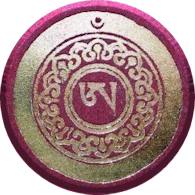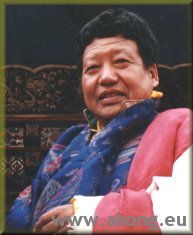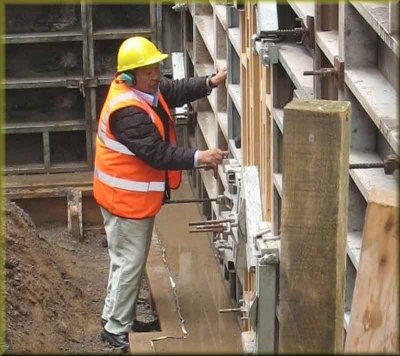
Akong Rinpoché Establishing Buddha-Dharma
Part Eight: The Samye Project
 The Temple was Phase One of a two-phase project, the second part would include new accommodation and dining facilities, administration spaces, libraries, lecture rooms and museums. The planning permission obtained in 1979 for the temple was in fact based on this overall project—a rectangular set of buildings with an inner courtyard—designed with much consultation and re-drawing by Akong Rinpoché
and architect the late Peter Lebaski. Following Peter’s death, Rinpoché worked with various architects as the years progressed. During that time, his own understanding developed as to how Phase Two of the project should best be. Much of the later work was done with engineer-architect David Cameron.
The Temple was Phase One of a two-phase project, the second part would include new accommodation and dining facilities, administration spaces, libraries, lecture rooms and museums. The planning permission obtained in 1979 for the temple was in fact based on this overall project—a rectangular set of buildings with an inner courtyard—designed with much consultation and re-drawing by Akong Rinpoché
and architect the late Peter Lebaski. Following Peter’s death, Rinpoché worked with various architects as the years progressed. During that time, his own understanding developed as to how Phase Two of the project should best be. Much of the later work was done with engineer-architect David Cameron.
As mentioned, the completion of Phase Two was the last item of things to be completed on Rinpoché’s list of essential projects for this life: one that saw its completion only weeks before his death. A considerable pause occurred after the temple opening, due to the shift of focus to Holy Isle, and the subsequent time it took to raise the necessary funds and to find the best way to build Phase Two. This delay was probably a good thing, as Rinpoché’s thinking about Phase Two evolved on an almost yearly basis, making the final version of Phase Two, as we see it now, very different from the initial conception in 1979. Two factors were important here:
![]() 1. The change in lifestyle and standards experienced by the whole world: things such as the universal presence of internet and audio-visual communications, the standards visitors and guests expect in institutions and so forth. It became necessary to build a centre suited to the first half of the twenty-first century rather than to extend the rustic status-quo of the Johnstone
House community of the late twentieth century.
1. The change in lifestyle and standards experienced by the whole world: things such as the universal presence of internet and audio-visual communications, the standards visitors and guests expect in institutions and so forth. It became necessary to build a centre suited to the first half of the twenty-first century rather than to extend the rustic status-quo of the Johnstone
House community of the late twentieth century.
![]() 2. Building regulations and health-and-safety regulations increased at an almost exponential pace in the UK during the 1990s. Furthermore, Samye Ling was no longer a very small religious charity bumbling along unnoticed, as it had been in the 1970s and 1980s. It was on its way up and becoming one of the top hundred charities in the UK and was therefore under much more scrutiny. The insurers were becoming more powerful and more exigent: without complying properly to their demands,
the centre would have to close to paying guests. Due to these and other reasons, no very much liked by Rinpoché, it was no longer possible for the Samye Ling community to take total charge of the building work.
2. Building regulations and health-and-safety regulations increased at an almost exponential pace in the UK during the 1990s. Furthermore, Samye Ling was no longer a very small religious charity bumbling along unnoticed, as it had been in the 1970s and 1980s. It was on its way up and becoming one of the top hundred charities in the UK and was therefore under much more scrutiny. The insurers were becoming more powerful and more exigent: without complying properly to their demands,
the centre would have to close to paying guests. Due to these and other reasons, no very much liked by Rinpoché, it was no longer possible for the Samye Ling community to take total charge of the building work.
 Rinpoché had truly loved the community effort that had occurred during the building of the temple. He told me once, in the very early 1980s:
Rinpoché had truly loved the community effort that had occurred during the building of the temple. He told me once, in the very early 1980s:
“You know, even if I received a donation tomorrow and could have the temple finished professionally very quickly, I wouldn’t. This is giving so many people an opportunity to either take part in the building of history themselves or else to be a sponsor and gain benefit that way. That is beyond price.”
By the time that the Phase Two wing containing the present dining-room was due to be built, it was obvious that most of the work would now need to be done professionally. There would still be some volunteer participation but it was to be by far the smaller part of the work. Rinpoché had no choice but to accept this very different “feel” of having outside contractors very present, day after day, in the centre rather than that unique atmosphere created by the community members enthusiastically building their own project. However, “you have to accept” was one of the most frequent teachings given by Rinpoché and he applied it equally to himself. Fortunately, his love of taking part in the building work and inspiring a team effort could still manifest, as there were continuous, smaller developments happening in Samye Ling itself, such as the conversion of old portable buildings into the Lotus Lodge, the conversion of the byre into workshops, the various developments in the prefabricated block now housing the Tibetan Tea Rooms and the shop, not to mention the acquisition and conversion of Glenscorrodale Farm on Arran into a men’s retreat and various conversion or building jobs to be done in the European of African centres.

Akong Rinpoché became very expert at using architects plans and took charge of all the conceptual developments of Phase Two, along with his building team and architects. He was also delighted when, with now draconian health-and-safety measures in place, he was one of the few non-employees to be allowed into the closed area of construction for the final wing of Phase Two. He spent a lot of time there, whenever he could, in his hard hat. It is quite possible, as some people comment, that Rinpoché actually enjoyed building work. It kept him fit and “grounded”, in some ways. My opinion is that there was much more to it than that. His interactions with the builders had two very important aspects revealing him as a teacher:
![]() 1. As in other circumstances, Rinpoché was the living presence of Mahamudra: mindful, deep, centred, emotionally uninvolved with what he was doing and so forth. No one could work with him without learning from the way in which he himself worked. It reminds me of Tilopa teaching Naropa, at one point, without any words. Naropa learned through what Tilopa did (and how he did it) and not through what he said. Any practical work, on the building site or in the garden or in the sewing-room, with Rinpoché was Mahamudra teaching—the living demonstration of what was being taught in the shrine room.
1. As in other circumstances, Rinpoché was the living presence of Mahamudra: mindful, deep, centred, emotionally uninvolved with what he was doing and so forth. No one could work with him without learning from the way in which he himself worked. It reminds me of Tilopa teaching Naropa, at one point, without any words. Naropa learned through what Tilopa did (and how he did it) and not through what he said. Any practical work, on the building site or in the garden or in the sewing-room, with Rinpoché was Mahamudra teaching—the living demonstration of what was being taught in the shrine room.
![]() 2. Working with Rinpoché gave people the chance to talk with him. It was not like the “interviews”, in the hushed space of the conference centre but a different area of contact that suited some people much more than a formal interview. They would slide in their questions or their requests for advice on their life while actively being by his side and focused on some job or other. I estimate hundreds of people must have received significant life-advice or practice guidance in such
circumstances.......
2. Working with Rinpoché gave people the chance to talk with him. It was not like the “interviews”, in the hushed space of the conference centre but a different area of contact that suited some people much more than a formal interview. They would slide in their questions or their requests for advice on their life while actively being by his side and focused on some job or other. I estimate hundreds of people must have received significant life-advice or practice guidance in such
circumstances.......
continue to the next part of the story (for now): Establishing the Mahamudra and Six Yoga Teachings
